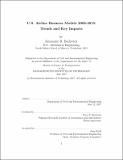| dc.contributor.advisor | Peter P. Belobaba. | en_US |
| dc.contributor.author | Bachwich, Alexander R | en_US |
| dc.contributor.other | Massachusetts Institute of Technology. Department of Civil and Environmental Engineering. | en_US |
| dc.coverage.spatial | n-us--- | en_US |
| dc.date.accessioned | 2017-09-15T14:21:55Z | |
| dc.date.available | 2017-09-15T14:21:55Z | |
| dc.date.copyright | 2017 | en_US |
| dc.date.issued | 2017 | en_US |
| dc.identifier.uri | http://hdl.handle.net/1721.1/111264 | |
| dc.description | Thesis: S.M. in Transportation, Massachusetts Institute of Technology, Department of Civil and Environmental Engineering, 2017. | en_US |
| dc.description | This electronic version was submitted by the student author. The certified thesis is available in the Institute Archives and Special Collections. | en_US |
| dc.description | Cataloged from student-submitted PDF version of thesis. | en_US |
| dc.description | Includes bibliographical references (pages 121-125). | en_US |
| dc.description.abstract | This thesis focuses on the evolution of U.S. airline business models from 2006-2015, and the impacts of these changes on other stakeholders in the U.S. air transportation system. The U.S. airline industry has been affected by increasingly volatile profit cycles since its deregulation in 1978. This volatility has led to major changes in the industry, including cost convergence between traditional Low Cost Carriers (LCCs) and Network Legacy Carriers (NLCs), multiple rounds of consolidation, and most recently a period of "Capacity Discipline" where high fuel prices and a reduced number of competitors led to slower-than-average capacity growth. The combined effects of these changes led to the emergence of a new business model: the "Ultra Low Cost Carrier" (ULCC). In this thesis, we conduct an analysis of ULCCs in the U.S. and demonstrate how these carriers' business models, costs, and effects on air transportation markets differ from those of the traditional LCCs. We also explore how the network and fleet strategies of airlines using all three business models have changed, highlighting key trends such as the decline in 50 seat jet use by NLCs and the varying network strategies of ULCCs. In the second half of the thesis, we examine how these changes in airline business models have affected other stakeholders in the U.S. transportation system. We describe how average fares have changed from 2006-2015 in the top U.S. markets. Then, using econometric models, we examine the effects of ULCC and LCC presence, entry, and exit on base airfares, and how these effects have changed over time. We also explore how evolving airline business models have impacted communities and their local airports. We find that seat capacity has grown at large hub airports from 2006-2015, whereas smaller airports have all seen declines in service levels to varying degrees. In particular, we examine how secondary airports in major metro areas have been affected by changing LCC strategies, and how the smallest airports have experienced significant declines in NLC service, yet some gains in ULCC service. Finally, we discuss the public policy implications of these service changes, and what policy options airports and communities have at both a local and national level to improve their level of commercial air service. | en_US |
| dc.description.statementofresponsibility | by Alexander R. Bachwich. | en_US |
| dc.format.extent | 126 pages | en_US |
| dc.language.iso | eng | en_US |
| dc.publisher | Massachusetts Institute of Technology | en_US |
| dc.rights | MIT theses are protected by copyright. They may be viewed, downloaded, or printed from this source but further reproduction or distribution in any format is prohibited without written permission. | en_US |
| dc.rights.uri | http://dspace.mit.edu/handle/1721.1/7582 | en_US |
| dc.subject | Civil and Environmental Engineering. | en_US |
| dc.title | U.S. airline business models 2006-2015 : trends and key impacts | en_US |
| dc.title.alternative | US airline business models 2006-2015 : trends and key impacts | en_US |
| dc.title.alternative | United States airline business models 2006-2015 : trends and key impacts | en_US |
| dc.type | Thesis | en_US |
| dc.description.degree | S.M. in Transportation | en_US |
| dc.contributor.department | Massachusetts Institute of Technology. Department of Civil and Environmental Engineering | |
| dc.identifier.oclc | 1003292805 | en_US |
